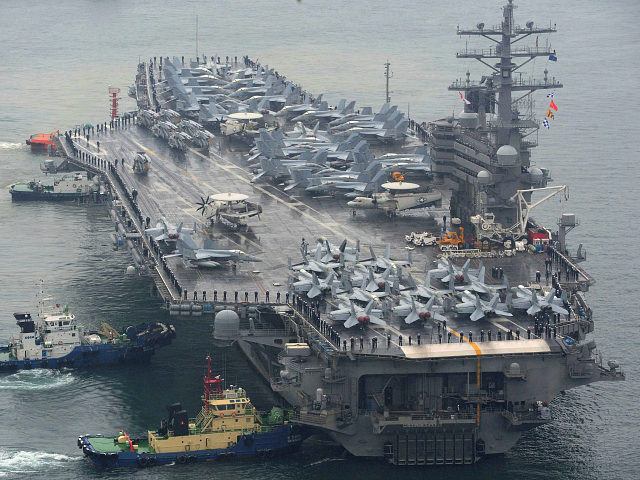The aircraft carrier USS Ronald Reagan completed a patrol of disputed waters in the South China Sea and anchored in Manila Bay on Tuesday, marking the third U.S. carrier patrol of the region in 2018.
Meanwhile, Chinese warships conducted combat exercises near Taiwan, and Secretary of Defense Jim Mattis landed in Beijing for momentous meetings with Chinese officials.
The Ronald Reagan, which weighs in at 97,000 tons and carries over 70 aircraft, sailed through a region China has aggressively militarized with missiles, electronic warfare equipment, and long-range bombers.
At a press conference aboard the ship, Rear Adm. Marc Dalton told reporters the American military presence protects “freedom of the seas, unimpeded commerce,” and “adherence to the rules-based international order” while deterring “conflict and coercion.”
It was not necessary for Dalton to name China as the subject of these remarks as no other power could plausibly threaten freedom of the seas or the trillion dollars in annual commerce that flows through the area.
CNBC on Monday quoted analysts who believe China is preparing to push beyond even the vast area of the South China Sea it claims, projecting power into the Pacific Ocean and Mekong River. One of the less openly-touted goals of the vast “Belt and Road” infrastructure project is to give Chinese land, air, and naval forces access to bases and ports further away from mainland China.
Chinese ships have been seen probing areas beyond the “nine-dash line” Beijing uses to claim historical dominion over all of the contested islands in the South China Sea. Sometimes they ask permission from local governments and pledge to conduct scientific research, but not always.
“Many believe the Chinese are interested in the area because of military reasons – largely intended to enhance its surveillance of the Western Pacific waters with U.S. military force concentrations in Guam and further afield in Hawaii in mind,” Collin Koh Swee Lean of Singapore’s Nanyang Technological University told CNBC.
A group of Chinese warships has been holding combat drills near Taiwan every day for the past week, including operations in the Taiwan Strait. According to the Chinese military, the drills were testing “the military and training abilities of warship, aviation, and coastal defense troops, via organizing real combat training in multiple areas of the ocean.”
The Taiwanese government stressed there was no cause for undue alarm from the Chinese drills, which have been carefully monitored by Taiwanese defense forces.
The Trump administration has been considering a U.S. Navy patrol of the Straits of Taiwan, possibly even with an aircraft carrier, an exercise last undertaken by the Bush administration in 2007.
Mattis portrayed his trip to China as primarily a listening tour. “I want to go in right now without basically poisoning the well, at this point, as if my mind’s already made up. I’m going there to have a conversation,” he said on Monday.
On the other hand, just a few weeks ago, Mattis said he disinvited China from the international RIMPAC exercise as an “initial response” to its militarization of the South China Sea and said China could face “much larger consequences” if it continues moving weapons into the area.

COMMENTS
Please let us know if you're having issues with commenting.